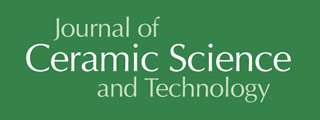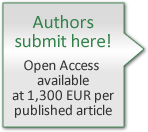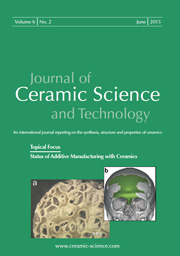Articles
All articles | Recent articles
Numerical Prediction of Effective Thermal Conductivity of Refractory Materials: Methodology and Sensitivity Analysis
R. Zehmisch1, C. Demuth1, A. Al-Zoubi1, M.A.A. Mendes1, F. Ballani2, S. Ray1, D. Trimis1
1 Institute of Thermal Engineering, Technische Universität Bergakademie Freiberg, Gustav-Zeuner-Straße 7, D-09596 Freiberg, Germany
2 Institute of Stochastics, Technische Universität Bergakademie Freiberg, Prüferstraße 9, D-09596 Freiberg, Germany
received November 10, 2013, received in revised form January 20, 2014, accepted March 14, 2014
Vol. 5, No. 2, Pages 145-154 DOI: 10.4416/JCST2013-00041
Abstract
The present paper deals with numerical predictions of the effective thermal conductivity (keff) of refractory materials. The composite is modelled using a geometry generation method; either the Coloured Dead Leaves Model (CDLM) or the modified version of the Random Sequential Adsorption (RSA) algorithm, for coarse grain components. On the other hand, there are constituents which could not be resolved by the computational model and are, therefore, treated as a continuous interstitial phase, termed as the ‘unresolved’ or the ‘rest’ material. The generated random geometry is discretised employing a uniform grid in the computational domain, where the heat conduction equation is solved with either the Thermal Lattice-Boltzmann Method (TLBM) or the Finite Volume Method (FVM). From the steady-state solution of the heat conduction equation, keff is determined using a simple averaged relation. This investigation also comprises the sensitivity analysis of the presented methodology with regard to the isotropy of generated geometry, the reproducibility of results, the employed shape of grains and the unknown thermal conductivity of ‘rest’ material. Results indicate that keff is linearly dependent on the last, whereas it is nearly insensitive to other parameters.
![]() Download Full Article (PDF)
Download Full Article (PDF)
Keywords
Effective thermal conductivity, refractory materials, thermal lattice-Boltzmann method, random sequential adsorption, sensitivity analysis
References
1 Garbers-Craig, A.M.: How cool are refractory materials?, J. South. Afr. Inst. Min. Metall., 108, 491 – 506, (2008).
2 Tomeczek, J., Suwak, R.: Thermal conductivity of carbon-containing refractories, Ceram. Int., 28, 601 – 607, (2002).
3 Barea, R., Belmonte, M., Osendi, M.I., Miranzo, P.: Thermal conductivity of Al2O3/SiC platelet composites, J. Eur. Ceram. Soc., 23, 1773 – 1778, (2003).
4 Veyret, D., Cioulachtjian, S., Tadrist, L., Pantaloni, J.: Effective thermal conductivity of a composite material: a numerical approach, J. Heat Transfer, 115, 866 – 871, (1993).
5 Zhou, H., Zhang, S., Yang, M.: The effect of heat-transfer passages on the effective thermal conductivity of high filler loading composite materials, Compos. Sci. Technol., 67, 1035 – 1040, (2007).
6 Maxwell, J.C.: A treatise on electricity and magnetism. Clarendon Press, Oxford, 1873.
7 Petrasch, J., Schrader, B., Wyss, P., Steinfeld, A.: Tomography-based determination of the effective thermal conductivity of fluid-saturated reticulate porous ceramics, J. Heat Transfer, 130, 032602 (10 pp.), (2008).
8 Dondero, M., Cisilino, A.P., Carella, J.M., Tomba, J.P.: Effective thermal conductivity of functionally graded random micro-heterogeneous materials using representative volume element and BEM, Int. J. Heat Mass Transfer, 54, 3874 – 3881, (2011).
9 He, X., Chen, S., Doolen, G.D.: A novel thermal model for the lattice Boltzmann method in incompressible limit, J. Comput. Phys., 146, 282 – 300, (1998).
10 Wang, M., Pan, N.: Predictions of effective physical properties of complex multiphase materials, Mater. Sci. Eng., R, 63, 1 – 30, (2008).
11 Qian, J., Li, Q., Yu, K., Xuan, Y.: A novel method to determine effective thermal conductivity of porous materials, Sci. China, Ser. E: Technol. Sci., 47, 716 – 724, (2004).
12 Wang, M., Wang, J., Pan, N., Chen, S.: Mesoscopic predictions of the effective thermal conductivity for microscale random porous media, Phys. Rev. E, 75, 036702 (10 pp.), (2007).
13 Wang, M., Wang, J., Pan, N., Chen, S., He, J.: Three-dimensional effect on the effective thermal conductivity of porous media, J. Phys. D.: Appl. Phys., 40, 260 – 265, (2007).
14 Wang, M., He, J., Yu, J., Pan, N.: Lattice Boltzmann modeling of the effective thermal conductivity for fibrous materials, Int. J. Therm. Sci., 46, 848 – 855, (2007).
15 Wang, M., Pan, N., Wang, J., Chen, S.: Mesoscopic simulations of phase distribution effects on the effective thermal conductivity of microgranular porous media, J. Colloid Interface Sci., 311, 562 – 570, (2007).
16 Wang, M., Meng, F., Pan, N.: Transport properties of functionally graded materials, J. Appl. Phys., 102, 033514 (7 pp.), (2007).
17 Roungos, V., Aneziris, C.G., Berek, H.: Novel Al2O3-C refractories with less residual carbon due to nanoscaled additives for continuous steel casting applications, Adv. Eng. Mater., 14, 255 – 264, (2012).
18 Roungos, V., Aneziris, C.G.: Improved thermal shock performance of Al2O3-C refractories due to nanoscaled additives, Ceram. Int., 38, 919 – 927, (2012).
19 Brachhold, N., Aneziris, C.G., Stein, V., Roungos, V., Moritz, K.: Low carbon content and carbon-free refractory materials with high thermal shock resistance, (in German), Keram. Z., 64, 109 – 114, (2012).
20 Stein, V.: Contribution to the characteristic improvement of carbon bonded doloma refractories by addition of functional ceramic materials, Ph.D. thesis, Technische Universität Bergakademie Freiberg, Freiberger Forschungshefte, A 905, (2011).
21 Schwieger, K.-H.: Feuerfestmassen. In: Becker, G.W., Braun, D., Woebcken, W. (Eds.): Kunststoffhandbuch, Vol. 10 Duroplaste, (in German), Carl Hanser Verlag, München, 1096 – 1104, 1988.
22 Irie, S., Rappolt, J.: Phenolic resin for refractories. In: Pilato, L.: Phenolic Resins: A Century of Progress, Springer-Verlag, Berlin, chapter 19, 503 – 515, 2010.
23 Haynes, W.M., Lide, D.R., Bruno, T.J. (Eds.): CRC Handbook of Chemistry and Physics. 94th edition. CRC Press, Boca Raton, 2013.
24 Klein, C., Hurlbut, Jr., C.S.: Manual of Mineralogy. 21st edition. John Wiley & Sons, New York, 1999.
25 Martin, C.A., Sandler, J.K.W., Shaffer, M.S.P., Schwarz, M.-K., Bauhofer, W., Schulte, K., Windle, A.H.: Formation of percolating networks in multi-wall carbon-nanotube-epoxy composites, Compos. Sci. Technol., 64, 2309 – 2316, (2004).
26 Slobodian, P., Riha, P., Lengalova, A., Svoboda, P., Saha, P.: Multi-wall carbon nanotube networks as potential resistive gas sensors for organic vapor detection, Carbon, 49, 2499 – 2507, (2011).
27 Anthony, J.W., Bideaux, R.A., Bladh, K.W., Nichols, M.C.: Handbook of mineralogy - Vol. III: Halides, Hydroxides, Oxides. Mineral Data Publishing, Tucson, 1997.
28 Thostenson, E.T., Chou, T.-W.: On the elastic properties of carbon nanotube-based composites: modelling and characterization, J. Phys. D: Appl. Phys., 36, 573 – 582, (2003).
29 Granqvist, C.G., Buhrmann, R.A.: Ultrafine metal particles, J. Appl. Phys., 47, 2200 – 2219, (1976).
30 Kiss, L.B., Söderlund, J., Niklasson, G.A., Granqvist, C.G.: New approach to the origin of lognormal size distributions of nanoparticles, Nanotechnology, 10, 25 – 28, (1999).
31 Matheron, G.: Random sets and integral geometry. John Wiley & Sons, New York, 1975.
32 Feder, J.: Random sequential adsorption, J. Theor. Biol., 87, 237 – 254, (1980).
33 Torquato, S.: Random heterogeneous materials: microstructure and macroscopic properties. Springer-Verlag, New York, 2002.
34 Ballani, F., Daley, D.J., Stoyan, D.: Modelling the microstructure of concrete with spherical grains, Comput. Mater. Sci., 35, 399 – 407, (2006).
35 Goldstein, H., Poole, C.P., Safko, J.L.: Classical mechanics. Third edition, Addison-Wesley, San Francisco, 2002.
36 ISO 1151 – 1, Flight dynamics - Concepts, quantities and symbols – Part 1: Aircraft motion relative to the air, 1988.
37 Zehmisch, R., Al-Zoubi, A., Ray, S., Trimis, D., Ballani, F., van den Boogaart, K.G.: Numerical determination of effective thermal conductivity of refractory materials, Refractories Worldforum, 4, 181 – 186, (2012).
38 Qian, Y.H., d'Humi̬res, D., Lallemand, P.: Lattice BGK models for Navier-Stokes equation, Europhys. Lett., 17, 479 Р484, (1992).
39 Peng, Y., Shu, C., Chew, Y.T.: A 3D incompressible thermal lattice Boltzmann model and its application to simulate natural convection in a cubic cavity, J. Comput. Phys., 193, 260 – 274, (2004).
40 D'Orazio, A., Succi, S.: Boundary conditions for thermal lattice Boltzmann simulations. In: Sloot, P.M.A., Abramson, D., Bogdanov, A.V., Dongarra, J.J., Zomaya, A.Y., Gorbachev, Y.E. (Eds.): Computational Science — ICCS 2003, Lecture Notes in Computer Science, 2657, Springer-Verlag, Berlin, 977 – 986, 2003.
41 Hashin, Z., Shtrikman, S.: A variational approach to the theory of the effective magnetic permeability of multiphase materials, J. Appl. Phys., 33, 3125 – 3131, (1962).
Copyright
Göller Verlag GmbH


